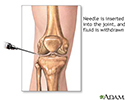Joint fluid culture
Culture - joint fluidJoint fluid culture is a laboratory test to detect infection-causing germs in a sample of fluid that is in a joint.
How the Test is Performed
A sample of joint fluid is needed. This may be done in a health care provider's office using a needle, or much less often, during an operating room procedure. Removing the sample is called joint fluid aspiration.
Joint fluid aspiration
Synovial fluid analysis is a group of tests that examine joint (synovial) fluid. The tests help diagnose and treat joint-related problems.

The fluid sample is sent to a lab. There, it is placed in a special dish and watched to see if bacteria or fungi grow. This is called a culture.
If these germs are detected, other tests may be done to further identify the infection-causing substance and its sensitivities or resistance to different antibiotics and determine the best treatment.
How to Prepare for the Test
Your provider will tell you how to prepare for the procedure. No special preparation is needed. But, tell your provider if you're taking a blood thinner, such as aspirin, warfarin (Coumadin) or clopidogrel (Plavix). These medicines can affect test results or your ability to take the test.
How the Test will Feel
After cleansing your skin thoroughly, usually, your provider will first inject numbing medicine into the skin with a small needle, which will sting. A larger needle is then used to draw out the synovial fluid.
This test may also cause some discomfort if the tip of the needle touches bone. The procedure usually lasts less than 1 to 2 minutes.
Why the Test is Performed
Your provider may order this test if you have unexplained pain and inflammation of a joint or a suspected joint infection.
Normal Results
The test result is considered normal if no organisms (bacteria or fungi) grow in the lab dish.
What Abnormal Results Mean
Abnormal results are a sign of infection in the joint. Infections may include:
-
Bacterial arthritis
Bacterial arthritis
Septic arthritis is inflammation of a joint due to a bacterial or fungal infection. Septic arthritis that is due to the bacteria that cause gonorrhe...
 ImageRead Article Now Book Mark Article
ImageRead Article Now Book Mark Article -
Fungal arthritis
Fungal arthritis
Fungal arthritis is swelling and irritation (inflammation) of a joint by a fungal infection. It is also called mycotic arthritis.
 ImageRead Article Now Book Mark Article
ImageRead Article Now Book Mark Article -
Gonococcal arthritis
Gonococcal arthritis
Gonococcal arthritis is inflammation of a joint due to a gonorrhea infection. Gonococcal arthritis is a type of septic arthritis. This is inflammati...
 ImageRead Article Now Book Mark Article
ImageRead Article Now Book Mark Article - Tuberculous arthritis
Risks
Risks of this test include:
- Infection of the joint -- unusual, but more common with repeated aspirations
- Bleeding into the joint space
References
Karcher DS, McPherson RA. Cerebrospinal, synovial, serous body fluids, and alternative specimens. In: McPherson RA, Pincus MR, eds. Henry's Clinical Diagnosis and Management by Laboratory Methods. 24th ed. Philadelphia, PA: Elsevier; 2022:chap 30.
O'Neil L, Tanner S, El-Gabalawy HS. Synovial fluid analyses, synovial biopsy, and synovial pathology. In: Firestein GS, Mclnnes IB, Koretzky GA, Mikuls TR, Neogi T, O'Dell JR, eds. Firestein & Kelly's Textbook of Rheumatology. 12th ed. Philadelphia, PA: Elsevier; 2025:chap 53.
-
Joint aspiration - illustration
Synovial fluid analysis is a series of tests performed on synovial (joint) fluid to help diagnose and treat joint-related abnormalities. To obtain a synovial fluid sample, a needle is inserted into the knee between the joint space. When the needle is in place the synovial fluid is then withdrawn. The sample is sent to the lab for analysis.
Joint aspiration
illustration
-
Joint aspiration - illustration
Synovial fluid analysis is a series of tests performed on synovial (joint) fluid to help diagnose and treat joint-related abnormalities. To obtain a synovial fluid sample, a needle is inserted into the knee between the joint space. When the needle is in place the synovial fluid is then withdrawn. The sample is sent to the lab for analysis.
Joint aspiration
illustration
Review Date: 10/27/2024
Reviewed By: Laura J. Martin, MD, MPH, ABIM Board Certified in Internal Medicine and Hospice and Palliative Medicine, Atlanta, GA. Also reviewed by David C. Dugdale, MD, Medical Director, Brenda Conaway, Editorial Director, and the A.D.A.M. Editorial team.



